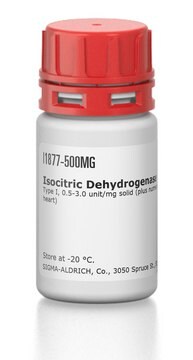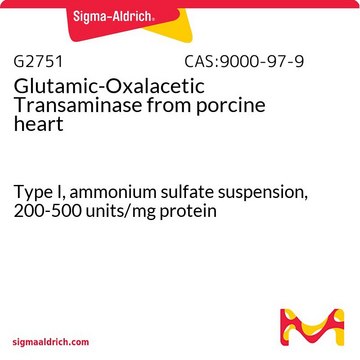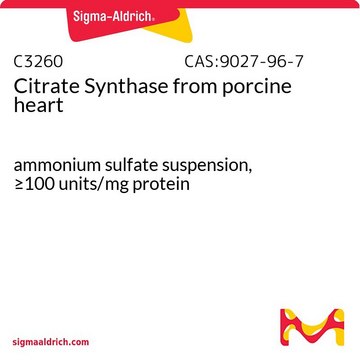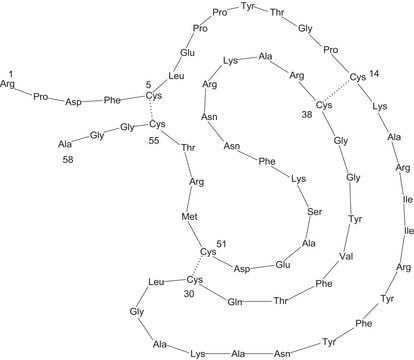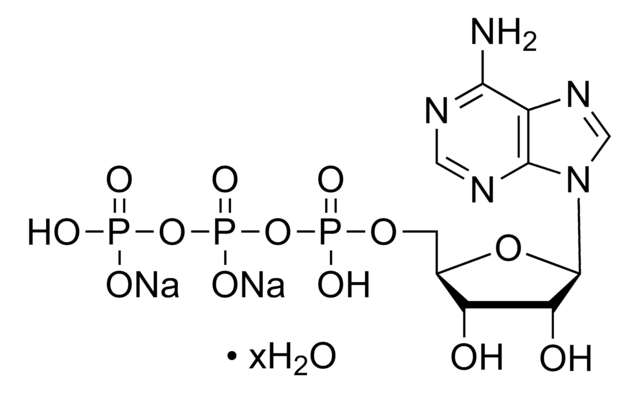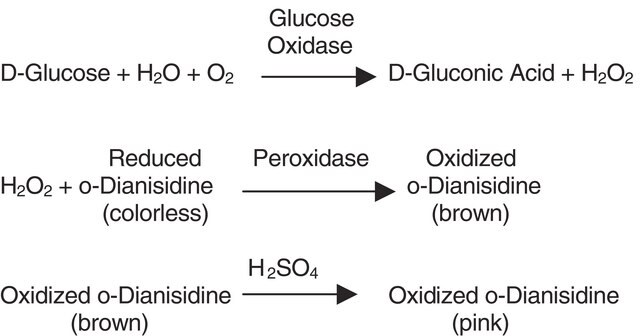A5384
Aconitase from porcine heart
Sinonimo/i:
Aconitate hydratase, Citrate (isocitrate) hydrolyase
Autenticatiper visualizzare i prezzi riservati alla tua organizzazione & contrattuali
About This Item
Numero CAS:
Numero MDL:
Codice UNSPSC:
12352204
NACRES:
NA.54
Prodotti consigliati
Origine biologica
Porcine heart
Stato
solid
PM
~66 kDa by gel filtration
Temperatura di conservazione
−20°C
Applicazioni
Aconitase may be usefull in diabetes research as well as to study structural conservation between iron-responsive element binding proteins (IRE-BP) and isomerases .
Azioni biochim/fisiol
Aconitase catalyses the stereo-specific isomerization of citrate to isocitrate via cis-aconitate in the tricarboxylic acid cycle. Aconitase is inhibited by cyanide, sulfide and copper and mercury at low concentrations. It is competitively inhibited by trans-aconitate. Aconitase contains an internal Fe-S cluster which is responsible for its activity.
Definizione di unità
One unit will convert 1.0 μmole of citrate (via cis-aconitate) to isocitrate per min at pH 7.4 at 25 °C.
Risultati analitici
Crude preparation containing aconitase activity
Codice della classe di stoccaggio
11 - Combustible Solids
Classe di pericolosità dell'acqua (WGK)
WGK 3
Punto d’infiammabilità (°F)
Not applicable
Punto d’infiammabilità (°C)
Not applicable
Dispositivi di protezione individuale
Eyeshields, Gloves, type N95 (US)
Scegli una delle versioni più recenti:
Possiedi già questo prodotto?
I documenti relativi ai prodotti acquistati recentemente sono disponibili nell’Archivio dei documenti.
I clienti hanno visto anche
Vinay A Patil et al.
The Journal of biological chemistry, 288(3), 1696-1705 (2012-11-30)
Cardiolipin (CL) is the signature phospholipid of mitochondrial membranes, where it is synthesized locally and plays a critical role in mitochondrial bioenergetic functions. The importance of CL in human health is underscored by the observation that perturbation of CL biosynthesis
Geoffrey F Kelso et al.
Chemistry & biology, 19(10), 1237-1246 (2012-10-30)
Superoxide (O(2)(·-)) is the proximal mitochondrial reactive oxygen species underlying pathology and redox signaling. This central role prioritizes development of a mitochondria-targeted reagent selective for controlling O(2)(·-). We have conjugated a mitochondria-targeting triphenylphosphonium (TPP) cation to a O(2)(·-)-selective pentaaza macrocyclic
Béatrice Py et al.
Molecular microbiology, 86(1), 155-171 (2012-09-13)
Biosynthesis of iron-sulphur (Fe-S) proteins is catalysed by multi-protein systems, ISC and SUF. However, 'non-ISC, non-SUF' Fe-S biosynthesis factors have been described, both in prokaryotes and eukaryotes. Here we report in vitro and in vivo investigations of such a 'non-ISC
S S Popov et al.
Eksperimental'naia i klinicheskaia farmakologiia, 75(7), 32-35 (2012-10-03)
A combined therapy with melaxen led to a decrease in the activity of gamma-glutamyl transpeptidase and the level of diene conjugates in blood serum of patients with the drug-induced hepatitis developing on the background of administration of antituberculous preparations. These
Meghna Mittal et al.
Microbiology (Reading, England), 159(Pt 1), 68-76 (2012-11-10)
The role of the CcpC regulatory protein as a repressor of the genes encoding the tricarboxylic acid branch enzymes of the Krebs cycle (citrate synthase, citZ; aconitase, citB; and isocitrate dehydrogenase, citC) has been established for both Bacillus subtilis and
Il team dei nostri ricercatori vanta grande esperienza in tutte le aree della ricerca quali Life Science, scienza dei materiali, sintesi chimica, cromatografia, discipline analitiche, ecc..
Contatta l'Assistenza Tecnica.